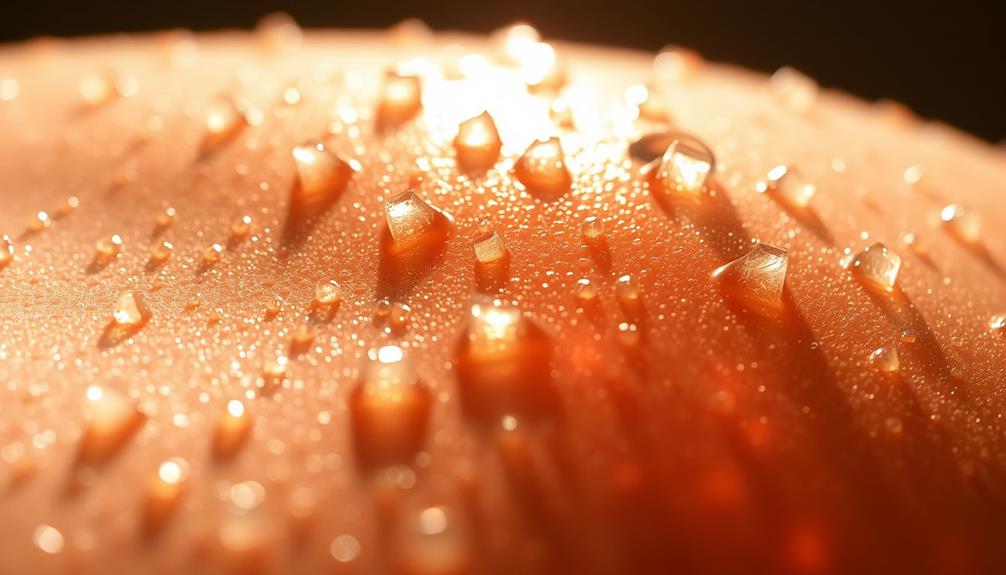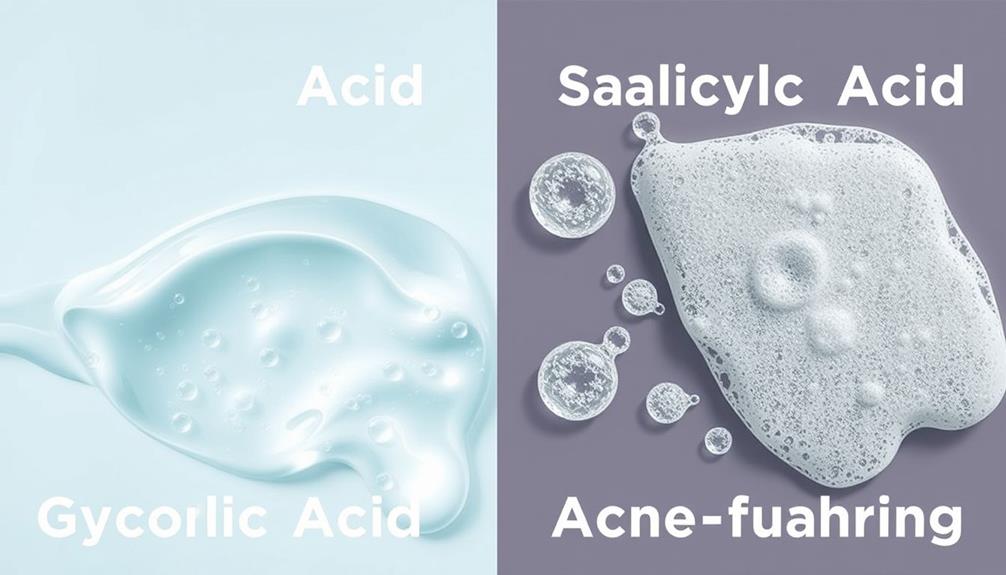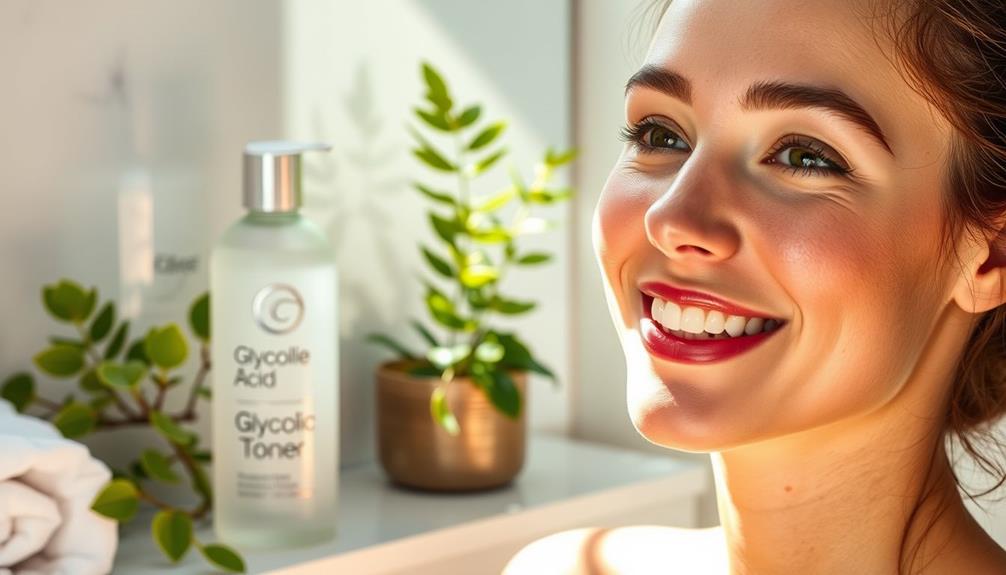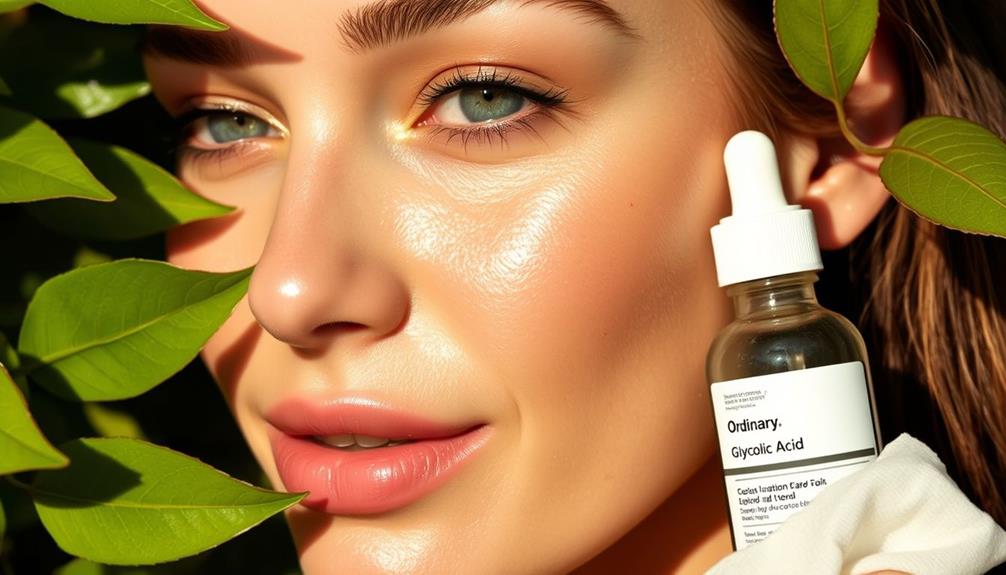With 10% glycolic acid, your skin will experience a powerful transformation. This effective alpha-hydroxy acid deeply penetrates your skin, encouraging exfoliation and cellular turnover. It aids in smoothing texture, brightening your complexion, and fading dark spots. Additionally, glycolic acid boosts collagen production, enhancing skin firmness and reducing fine lines. It also helps prevent acne breakouts by keeping pores unclogged. To reap these benefits, start slowly and pay attention to your skin’s response. By mastering how to use it effectively, you will unlock even more secrets to achieving radiant skin through the science of this incredible ingredient.
Key Takeaways
- 10% glycolic acid effectively enhances exfoliation by breaking down bonds between dead skin cells, promoting smoother and healthier skin texture.
- It stimulates collagen and elastin production, leading to firmer skin and reducing the appearance of fine lines over time.
- This concentration is ideal for fading hyperpigmentation and improving overall skin tone by accelerating cell turnover.
- Regular use of 10% glycolic acid brightens complexion and enhances skin clarity, making it effective for treating acne and preventing clogged pores.
Understanding Glycolic Acid

Glycolic acid, a powerful alpha-hydroxy acid derived from sugar cane, effectively exfoliates your skin, promoting a smoother and more radiant complexion. As the smallest AHA, glycolic acid penetrates deeply, breaking down the bonds between dead skin cells and enhancing cellular turnover. This process not only reveals fresher skin but also greatly improves skin texture.
Additionally, incorporating essential oils, such as Lavender and Tea Tree, into your routine can complement the exfoliating benefits of glycolic acid, providing aromatherapy for stress relief and promoting overall skin health.
By regularly incorporating glycolic acid into your skincare routine, you stimulate collagen production, leading to firmer, more youthful-looking skin. You'll notice a reduction in the appearance of fine lines and wrinkles, as well as a brighter complexion. Additionally, glycolic acid is a potent ally against hyperpigmentation, helping to fade dark spots and uneven skin tone over time.
Glycolic acid is commonly found in various formulations, such as serums and peels, with concentrations typically ranging from 5-10% for at-home use. When used consistently, you'll reveal the full benefits of its exfoliating properties, transforming your skin's overall health and appearance.
Key Benefits of Glycolic Acid

Glycolic acid offers several key benefits that can transform your skincare routine.
It helps with exfoliation and skin renewal, which is essential for maintaining a youthful appearance and can complement your efforts in developing digital creativity through interactive family activities.
Additionally, it brightens your complexion and effectively treats acne and hyperpigmentation.
Exfoliation and Skin Renewal
Regularly incorporating glycolic acid into your skincare routine can greatly enhance exfoliation and promote skin renewal for a smoother, more radiant complexion.
As the smallest alpha-hydroxy acid (AHA), glycolic acid penetrates the skin effectively, dissolving the bonds between dead skin cells. This process encourages the shedding of old, damaged cells, revealing healthier skin underneath.
Additionally, using essential oils, such as lavender or tea tree, can complement your skincare efforts by providing nourishing properties that support overall skin health natural alternatives to chemical products.
With consistent use, glycolic acid accelerates skin cell turnover, leading to improved texture and reduced fine lines over time.
You'll notice that the surface of your skin becomes smoother and more refined, making it easier for other active ingredients in your regimen to work effectively.
The ideal concentrations for at-home products, typically ranging from 5% to 10%, provide significant exfoliation without causing excessive irritation.
Brightening and Even Tone
Releasing a brighter, more even complexion is just one of the remarkable benefits of incorporating glycolic acid into your skincare routine. This powerhouse ingredient accelerates skin cell turnover, helping you shed dead skin cells to reveal enhanced skin clarity and radiance. If you struggle with hyperpigmentation or uneven skin tone, glycolic acid can notably diminish dark spots and contribute to a more uniform appearance.
Here's how glycolic acid works its magic:
| Benefit | Description |
|---|---|
| Brightening | Enhances overall skin brightness and radiance. |
| Exfoliating Properties | Smooths out rough patches for better light reflection. |
| Improved Skin Clarity | Promotes a clearer, more luminous complexion. |
| Uniform Skin Tone | Diminishes hyperpigmentation and dark spots over time. |
Regular use of glycolic acid-based products helps you achieve a healthier glow and improves your skin's overall appearance. By stimulating collagen production, you'll not only enhance your skin tone but also experience a renewed vibrancy, making glycolic acid an essential addition to your skincare arsenal.
Acne and Hyperpigmentation Treatment
Struggling with acne and hyperpigmentation? Incorporating glycolic acid into your skincare routine can effectively tackle these issues. This powerful ingredient exfoliates your skin by dissolving the bonds between dead skin cells, preventing clogged pores that lead to acne breakouts. With regular use, glycolic acid not only helps clear existing acne but also reduces the appearance of post-acne scars, improving your overall skin texture.
For those with curly hair, maintaining healthy skin is equally important, so consider exploring hair products for curly hair that complement your skincare regimen.
Glycolic acid accelerates skin cell turnover, which is essential for fading hyperpigmentation and dark spots. Over time, you'll notice a brighter, more even skin tone as it encourages your skin to shed old, discolored cells.
Additionally, glycolic acid stimulates collagen production, enhancing your skin's elasticity and minimizing fine lines, leading to a youthful and resilient complexion.
Mechanism of Action

When you apply glycolic acid, it starts breaking down the bonds that keep dead skin cells stuck to your surface. This exfoliation process not only clears away the old cells but also stimulates collagen and elastin production, helping your skin feel firmer and more elastic.
Incorporating practices from self-exploration through body awareness can enhance your overall well-being as you improve your skin's texture.
You'll notice a smoother texture and a brighter complexion with regular use.
Exfoliation Process Explained
Glycolic acid works by dissolving the bonds between dead skin cells, making it easier for your skin to shed these layers and reveal a fresher complexion underneath.
As an alpha-hydroxy acid (AHA), glycolic acid penetrates deeply due to its small molecular size, enhancing its exfoliation capabilities. This chemical exfoliation effectively breaks down keratinocytes in the outer layer of your skin, promoting cellular turnover and accelerating the renewal process. Incorporating ingredients like glycolic acid can be especially beneficial in a consistent skincare routine to improve overall skin health and appearance, similar to how skincare patches deliver concentrated ingredients directly to the skin.
By facilitating the shedding of old, damaged cells, glycolic acid not only unclogs pores but also improves your skin texture. As the dead skin cells are removed, your skin becomes more receptive to other skincare products. This means that the active ingredients in your serums and moisturizers can absorb better and work more effectively.
Incorporating glycolic acid into your skincare routine can lead to a smoother, more vibrant complexion. Regular use can help you maintain an even skin tone while addressing issues like roughness and dullness.
Collagen Stimulation Benefits
By promoting cellular turnover, glycolic acid plays an essential role in stimulating collagen production, resulting in firmer and more elastic skin. This powerful acid works through exfoliation, removing dead skin cells and encouraging the skin to regenerate.
As new skin cells form, your body ramps up collagen production in the dermis, a crucial protein that maintains skin firmness and structure. Regular use of glycolic acid leads to a thicker, plumper skin appearance as it replenishes the collagen matrix.
The enhanced collagen synthesis not only improves skin firmness but also helps reduce fine lines and wrinkles, making your skin look more youthful and revitalized.
One reason glycolic acid is so effective is its small molecular size, allowing for deeper penetration and direct action on skin cells. When you incorporate glycolic acid into your skincare routine, you're not just exfoliating; you're actively boosting your skin's ability to produce collagen.
This dual action ultimately transforms your skin appearance, giving it a smoother, more radiant look. Embrace the benefits of glycolic acid and enjoy the youthful glow that comes from increased collagen production and improved skin texture.
Exfoliation and Skin Renewal

How can incorporating glycolic acid into your skincare routine transform your skin through effective exfoliation and renewal? By using this powerful alpha-hydroxy acid, you can experience remarkable benefits that enhance your complexion. Glycolic acid works by dissolving the bonds between dead skin cells, promoting gentle exfoliation and revealing a fresher layer beneath.
Here's what you can expect from regular use of glycolic acid:
- Improved Skin Texture: Say goodbye to dullness as glycolic acid reveals smoother, more radiant skin.
- Increased Collagen Production: By stimulating collagen, it helps achieve thicker, plumper skin while reducing fine lines and wrinkles.
- Enhanced Skin Renewal: Regular application promotes cellular turnover, allowing your skin to regenerate effectively.
With a recommended concentration of 5% to 10%, you can gradually increase usage to maximize results while ensuring your skin adjusts. Incorporate glycolic acid into your routine, and watch as your skin transforms, feeling renewed and revitalized.
Comparing Glycolic and Salicylic Acid

When choosing between glycolic and salicylic acid for your skincare routine, understanding their unique benefits can help you make the best decision for your skin type. Both acids excel in promoting skin radiance and improving skin texture, but they work in different ways.
Here's a quick comparison:
| Feature | Glycolic Acid | Salicylic Acid |
|---|---|---|
| Solubility | Water-soluble | Oil-soluble |
| Primary Function | Chemical exfoliation | Unclogging pores |
| Best For | Dull skin, uneven texture | Oily, acne-prone skin |
| Benefits | Enhances brightness, reduces acne scars | Reduces inflammation, soothes redness |
| Ideal Concentration | 5-10% for OTC products | 0.5-2% for OTC products |
Glycolic acid targets the surface of your skin, promoting chemical exfoliation and leaving your complexion bright. In contrast, salicylic acid penetrates deeper, effectively unclogging pores and reducing acne scars. Depending on your skin's needs, you may find one more beneficial than the other, or even consider alternating their use for best results.
Application Guidelines

To achieve the best results with glycolic acid, start with a lower concentration and gradually increase usage as your skin adjusts.
Begin with products that contain 5% to 10% glycolic acid, applying them once a week. As your skin tolerance improves, you can increase the frequency to two or three times per week.
Here are some application guidelines to keep in mind:
- Use at Night: Apply glycolic acid products in the evening to reduce UV sensitivity.
- Moisturize Afterward: Always follow up with a hydrating moisturizer to combat potential dryness and irritation.
- Monitor Your Skin Types: Pay attention to how your skin responds, and adjust frequency if irritation occurs.
Safe Combinations With Glycolic Acid

Combining glycolic acid with specific ingredients can enhance your skincare routine while minimizing irritation. For instance, pairing glycolic acid with lactic acid is an excellent choice, as both acids work together to smooth the skin and boost hydration without causing excessive irritation.
You can also consider using glycolic acid alongside niacinamide, which improves skin texture and tone while reducing irritation, promoting overall skin health.
To keep your skin hydrated, try combining glycolic acid with hydrating serums that contain hyaluronic acid. This combo can help minimize dryness and support your skin barrier.
However, when it comes to retinol, exercise caution. Both retinol and glycolic acid are potent actives; it's best to alternate their usage to prevent irritation.
While you can use vitamin C with glycolic acid, it's advisable to apply them at different times. For example, use vitamin C in the morning and glycolic acid at night to maximize their benefits and minimize sensitivity.
Managing Skin Sensitivity

When using glycolic acid, you need to be aware of your skin's sensitivity to avoid irritation.
Start with a patch test and consider hydration strategies to support your skin barrier.
Additionally, be mindful of ingredient combinations to guarantee a safe and effective routine.
Patch Testing Importance
Patch testing is essential for managing skin sensitivity, as it allows you to identify any adverse reactions to glycolic acid before fully incorporating it into your routine. This step is particularly important if you have sensitive skin, as glycolic acid can sometimes cause irritation or allergic reactions.
To effectively perform a patch test, follow these steps:
- Apply a small amount of glycolic acid to a discreet area of skin, like the inside of your wrist or behind your ear.
- Wait at least 48 hours to observe the test area for any signs of irritation, such as redness or discomfort.
- Monitor how your skin reacts; any adverse reactions indicate that you should reconsider using the product.
Hydration Support Strategies
To keep your skin balanced and comfortable while using glycolic acid, incorporating hydration support strategies is vital.
Start by applying a hydrating serum before your glycolic acid treatment. This can greatly reduce dryness and irritation, enhancing your skin's overall comfort.
After using glycolic acid, follow up with ceramide-based moisturizers. These products help reinforce your skin barrier, promoting hydration and minimizing potential skin sensitivity.
Always remember to perform patch tests before applying glycolic acid to gauge your individual skin sensitivity. This step is important in preventing adverse reactions.
Gradually introducing glycolic acid into your routine, beginning with lower concentrations and limited frequency, allows your skin to build tolerance and adapt effectively.
You can also consider combining glycolic acid with gentle, hydrating ingredients. This approach enhances moisture retention, ensuring your skin remains balanced and protected from excessive exfoliation.
Safe Ingredient Combinations
Finding the right ingredient combinations is vital for managing skin sensitivity while using glycolic acid. To maintain your skin barrier and minimize irritation, consider these effective pairings:
- Hyaluronic Acid: Apply this hydrating serum before glycolic acid to boost moisture and support the skin barrier.
- Lactic Acid: This AHA can enhance hydration when paired with glycolic acid, but avoid other AHAs and BHAs to prevent over-exfoliation.
- Vitamin C: You can use it with glycolic acid, but timing is important. Apply vitamin C in the morning and glycolic acid at night to reduce sensitivity.
Precautions When Using Glycolic Acid

When using glycolic acid, you'll want to take certain precautions to protect your skin from irritation and sensitivity.
First, always start with a lower concentration, ideally between 5-10%, and apply it once a week. Gradually increase the frequency to two or three times a week as your skin tolerates it. Patch testing is essential—apply a small amount on your skin to check for sensitivity before full application.
Keep in mind that glycolic acid can increase skin sensitivity to sunlight, so using a broad-spectrum sunscreen with at least SPF 30 during the day is vital.
To combat any dryness or irritation, apply a hydrating serum before the glycolic acid and follow up with ceramide-based moisturizers to support your skin barrier.
Avoid combining glycolic acid with other exfoliants, like AHAs and BHAs, to reduce the risk of over-exfoliation. Be cautious when using retinol alongside glycolic acid, as this can also heighten irritation.
Incorporating Glycolic Acid Into Skincare

Incorporating glycolic acid into your skincare routine can transform your complexion, but it's essential to start slowly to allow your skin to adjust. Begin with a product containing 5-10% glycolic acid to help build tolerance and minimize sensitivity.
Here are some tips to get you started:
- Patch test: Always perform a patch test before applying glycolic acid to your entire face, especially if you have sensitive skin.
- Evening application: Use glycolic acid products in the evening to reduce the risk of sun sensitivity and to maximize their effectiveness.
- Gradual frequency: Start with once a week and gradually increase usage to two or three times a week, depending on how your skin reacts to the exfoliation.
Frequently Asked Questions
How Does Glycolic Acid Improve Skin?
Glycolic acid improves your skin by dissolving dead skin cell bonds, boosting collagen production, and enhancing cellular turnover. You'll notice smoother texture, reduced fine lines, and a brighter, more even complexion with regular use.
Does Glycolic Acid Really Work?
Yes, glycolic acid really works! You'll notice smoother skin and reduced fine lines with regular use. Its exfoliating properties enhance the absorption of other products, giving your skincare routine a powerful boost for healthier, more radiant skin.
What Is the Science Behind Glycolic Acid Peel?
Glycolic acid peels work by breaking down dead skin cell bonds, allowing deeper exfoliation. This process stimulates collagen and elastin production, improving texture, reducing fine lines, and enhancing overall skin tone for a youthful appearance.
How Long Does It Take to See the Benefits of Glycolic Acid?
Like a sunrise breaking through the fog, you'll notice skin improvements in 4 to 6 weeks with consistent use. Targeted issues might take 8 to 12 weeks for significant changes, so patience is key.
Conclusion
So, if you thought perfect skin was just a myth reserved for Instagram influencers, think again!
With 10% glycolic acid, you can reveal the secret to a glowing complexion right in your bathroom cabinet.
Sure, you might experience a little tingling—who doesn't love a good skincare adventure?
Just remember to start slow and listen to your skin.
Embrace the journey, and soon enough, you'll be flaunting that flawless skin you once thought was out of reach!










